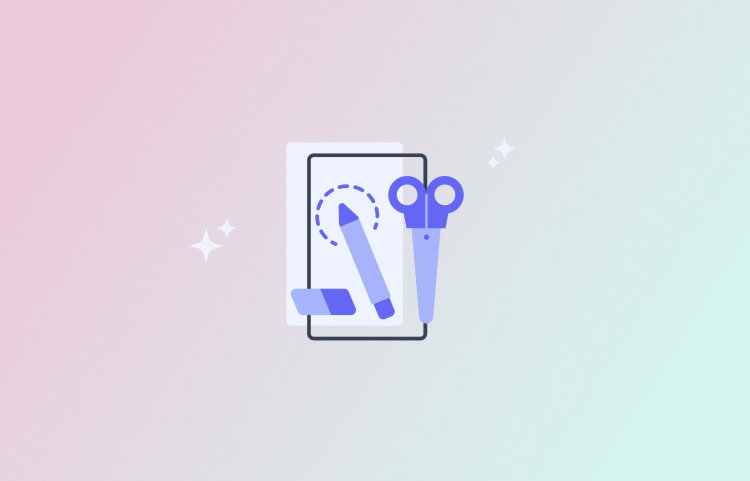
Amazon Sponsored Products (Ads) Made Easy: Strategy & Optimization
Trina, February 1, 2021
What does ‘sponsored' mean on Amazon?
Sponsored products are Amazon ads designed to promote individual listings and target shoppers who are looking for products like yours. These Amazon sponsored ads appear within search results and on product pages.
To get you started as smoothly as possible, in this guide we are covering the most important things you should know as a beginner about Sponsored Products ads that are the most popular and usually also the most effective ads on Amazon:
Basic terminology and metrics you should know to run Sponsored Ads
How do I create Sponsored Ads for my products – beginner's strategy
What Are Amazon Sponsored Products? How Do They Work?
Amazon Sponsored Products are keyword or product targeted ads that look very similar to organic search results and link to the product detail page. In terms of content, Sponsored Product ads are created automatically based on the advertised product listing, and are only indirectly customizable.
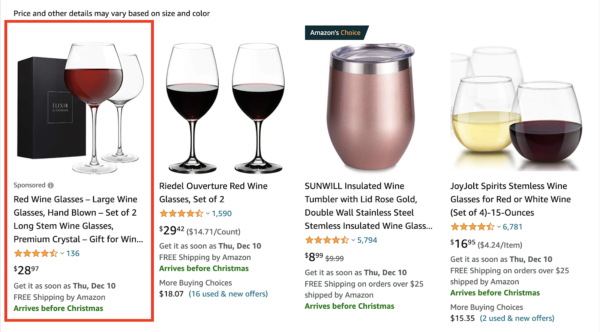
Sponsored Products Ads are displayed in 2 places:
Search results: At the beginning, middle, end, or next to the search result
Product pages: Display carousels on product pages
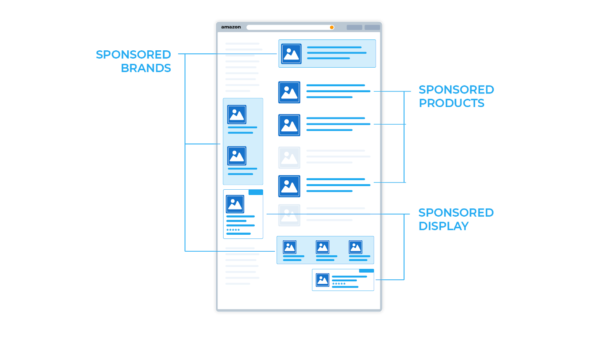
Amazon.com search results page
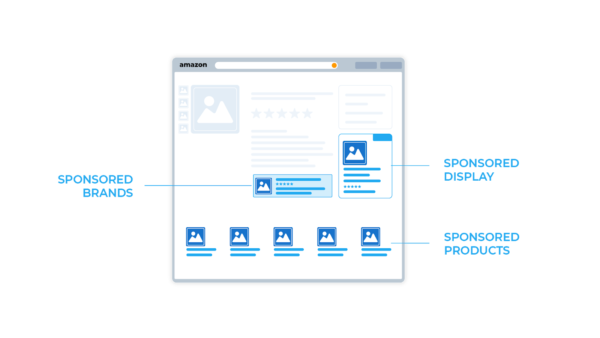
Amazon product page
Looking for more Amazon PPC background, data, and insights?
Whether you’re interested in a high-level analysis of Amazon Advertising, a detailed look at recent marketplace trends, or a deep dive into the nuances of specific product categories, our 2022 Amazon Advertising Benchmark Report can help you gain insight into the Amazon PPC landscape.
The report is based on a comprehensive analysis of over 2 million Sponsored Products campaigns and you can download it for free today.
Who can use Sponsored Products ads?
Both vendors and sellers can use Amazon Sponsored Products ads.
Here is an overview of all eligibility criteria for Amazon Sponsored Products ads:
ELIGIBILITY CRITERIA | SPONSORED PRODUCTS |
|---|---|
General | – Active account in good standing with Amazon – The ability to ship to the country in which you’re advertising – Valid payment method |
Seller Type | – Professional seller, vendor, Kindle Direct Publishing (KDP) author |
Product | – Adult, used, or refurbished products aren’t eligible – Products has to be in stock and in the Buy Box* |
Brand Registry | Not required |
Categories |
*To be eligible for the Featured Offer (Buy Box), your products must: 1) be available (in stock); 2) you must have been selling for 90 days; and 3) the product price should not significantly exceed the average price of the previous weeks to two months.
Are Amazon Sponsored Products Worth It?
Why should I try Amazon Sponsored ads?
For both sellers and vendors, Sponsored Products are known to be the main performance marketing channel on Amazon and a key revenue driver.
Amazon Sponsored Products ads appear directly in search results on Amazon — because of this prime location, the ads are visible for many potential customers.
By advertising on Amazon and with Amazon Sponsored Products ads specifically, you can get your products in front of shoppers who are later in the buyer’s journey (lower funnel). That means these shoppers already know what product they want and have a higher likelihood of making a purchase.
In comparison your ads on Google or Facebook would target a wider range of shoppers with varying levels of purchase intent.
Besides, unlike Google Ads, Amazon Sponsored Products are (still) cheaper and much more straightforward. Therefore, getting started on promoting products with Amazon Sponsored Ads is relatively easy.
Amazon Sponsored Products: PPC Model
Sponsored Ads are billed according to the PPC (Pay-Per-Click) model. That means advertisers only pay, if their ad is clicked.
The typical CPC (Cost-Per-Click) for Amazon.com currently ranges from a few cents up to 3 US dollars.
See CPC benchmarks below or in our free Sellics Amazon PPC Benchmarker [Beta].
The cost of the click is determined in a real time auction whenever an ad is shown. Every advertiser submits a bid and gets an ad position accordingly. However, the bid is different from the actual CPC as each advertiser only pays 1 cent more than the next highest bid.
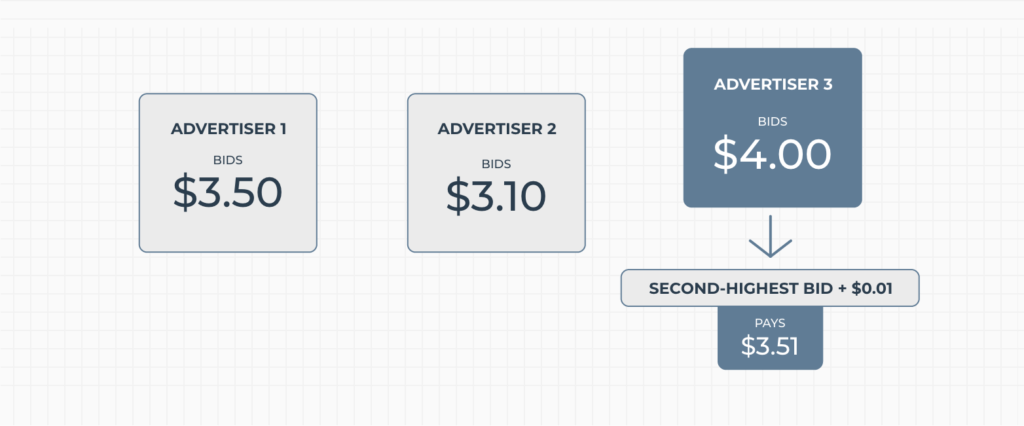
In the above example, Advertiser 3 wins the auction with a bid of $4.00. If this ad is clicked, the CPC charged to Advertiser 3 will be $3.51. This logic also applies for all following ad ranks, e.g. advertiser 1 (ad rank #2) pays $3.11.
Does Amazon Sponsored Products improve my organic rankings?
Yes. In fact, sales volume is one of the most potent factors for ranking on Amazon. These sales include not only organic sales but also sales from Amazon PPC campaigns, so an increase in sales from promoting products via Sponsored Products can indeed boost organic ranking.
That’s why ad campaigns are especially useful for launching new products. Even established products can, however, benefit by a lasting improvement of the Amazon ranking. More information on the relationship between Amazon SEO and Amazon PPC can be found in our blog articles.
Amazon Sponsored Ads Management: Basic Things to Know Before You Start
Sponsored Products: terminology
To manage Amazon Sponsored ads campaigns effectively, you need to first understand the basic elements of Amazon PPC.
AREA | EXPLANATION |
|---|---|
Targeting (Keyword, ASIN, Category, Views remarketing) | When you set up your Amazon PPC campaign, you can choose to target your ads based on keywords, product ASINs, categories on Amazon as well as remarketing on external websites to audiences that viewed certain products on Amazon (targeting options depend on the ad type). |
Search terms vs. Targets (e.g. Keywords) | ‘Search terms’ refers to any search query the customer types into the Amazon search field, or – for product page placements – the ASIN the ad appeared on. ‘Targets’ refer to what you, as the advertiser, bid on in your ad campaigns, e.g. specific keywords, ASINs or categories. Depending on the match type used, a target (e.g. a keyword) can cover multiple search terms. |
Keyword Match Types | Keyword Match Types determine the degree of match between the keyword and customer search term in order for an ad to appear on Amazon. There are 3 match types available (Broad, Phrase, Exact), all with varying degrees of ad targeting precision & management effort required. |
Negative Targeting | Negative targets are used to help sellers exclude unwanted search terms from their ad campaigns. When utilized effectively, negative targeting can be a very powerful tool to help you control your Amazon PPC activities. Negative targets can be both negative keywords (excluding impressions for certain searches) and negative ASINs (excluding impressions on certain product pages). |
Campaign types | There are automatic and manual campaigns. The main difference is that a manual campaign will give you more accurate results. In an automatic campaign, you let Amazon run your ads for you, and your ad will be automatically matched to all the search terms Amazon deems relevant to your product. In a manual campaign, you choose the targets you wish your ad to be displayed for, giving you greater ad targeting precision. |
Dynamic Bidding | Advertisers can choose to set fixed bids or use Amazon’s dynamic bidding options (‘bid down’, bid ‘up and down’), which allows Amazon to adjust your bids in real time based on the conversion probability. |
Adjust Bids by Placement | Advertisers can use this feature to modify bids to target Top of Search and Product Detail Pages. A bid modifier from 0% to 900% can be applied for targeted placements. |
Sponsored Products: key metrics
The following is a summary of the most important key performance indicators (KPIs) for Amazon Sponsored ads that will allow you to determine how successful your advertisements are.
To identify areas in which you can improve your advertising strategy, it’s useful to use tools like the free Sellics Amazon PPC Benchmarker [Beta] to see how your KPIs compare with other sellers in your marketplace and category.
KPI | HOW IS IT CALCULATED? | WHY IS IT IMPORTANT? |
|---|---|---|
ACOS = ad spend ÷ ad revenue x 100 | Allows you to see if your ads are profitable; also allows you to see how efficient your ads are compared with competitors | |
Return on Ad Spend (ROAS) | ROAS = ad revenue ÷ ad spend | ROAS is the inverse of ACoS. ROAS allows you to see if your ads are profitable; also allows you to see how efficient your ads are compared with competitors |
Cost per click (CPC) | CPC is determined in a second-price auction (see above) | CPC is a general indicator of competition intensity in a category |
Click-through-rate
(CTR) | Click-through-rate = number of clicks ÷ number of impressions x 100 | Click-through-rate is an indicator of how appealing your ads are to potential customers |
Conversion Rate
(CVR) | Conversion rate = number of orders ÷ number of clicks x 100 | Conversion rate is an indication of how persuasive your ads and products are; also as CVR goes up, so does profitability |
Amazon Sponsored Products benchmarks (for top categories: Electronics, Health & Household, Clothing)
How do you find out how well your Amazon PPC campaigns are doing? A crucial gauge of the success of your Amazon advertising strategies and campaigns is benchmarking. You need to compare your performance with peers in your marketplace and industry, differentiated by ad type.
Such tailored numbers are often near impossible to obtain. As such, based on advertising data of over $2.5b+ in Amazon ad spend data worldwide, Sellics has launched the brand new Sellics Benchmarker Tool [beta], giving advertisers benchmarkers for the most important KPIs specific to your industry and marketplace.
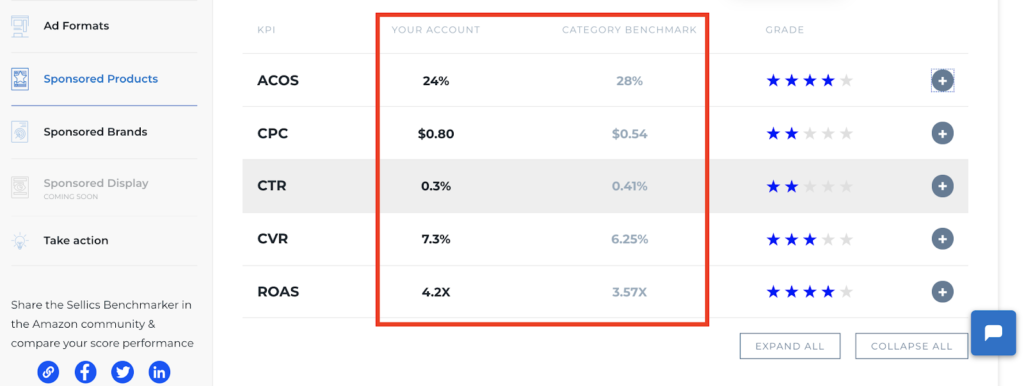
Here are benchmarks for key advertising KPIs for Sponsored Products, focusing on 3 top categories on Amazon.com US store: Electronics, Health & Household, and Clothing.
What is a good click rate for Amazon Sponsored Products?
Click-Through-Rate Across Ad Types and Top Categories
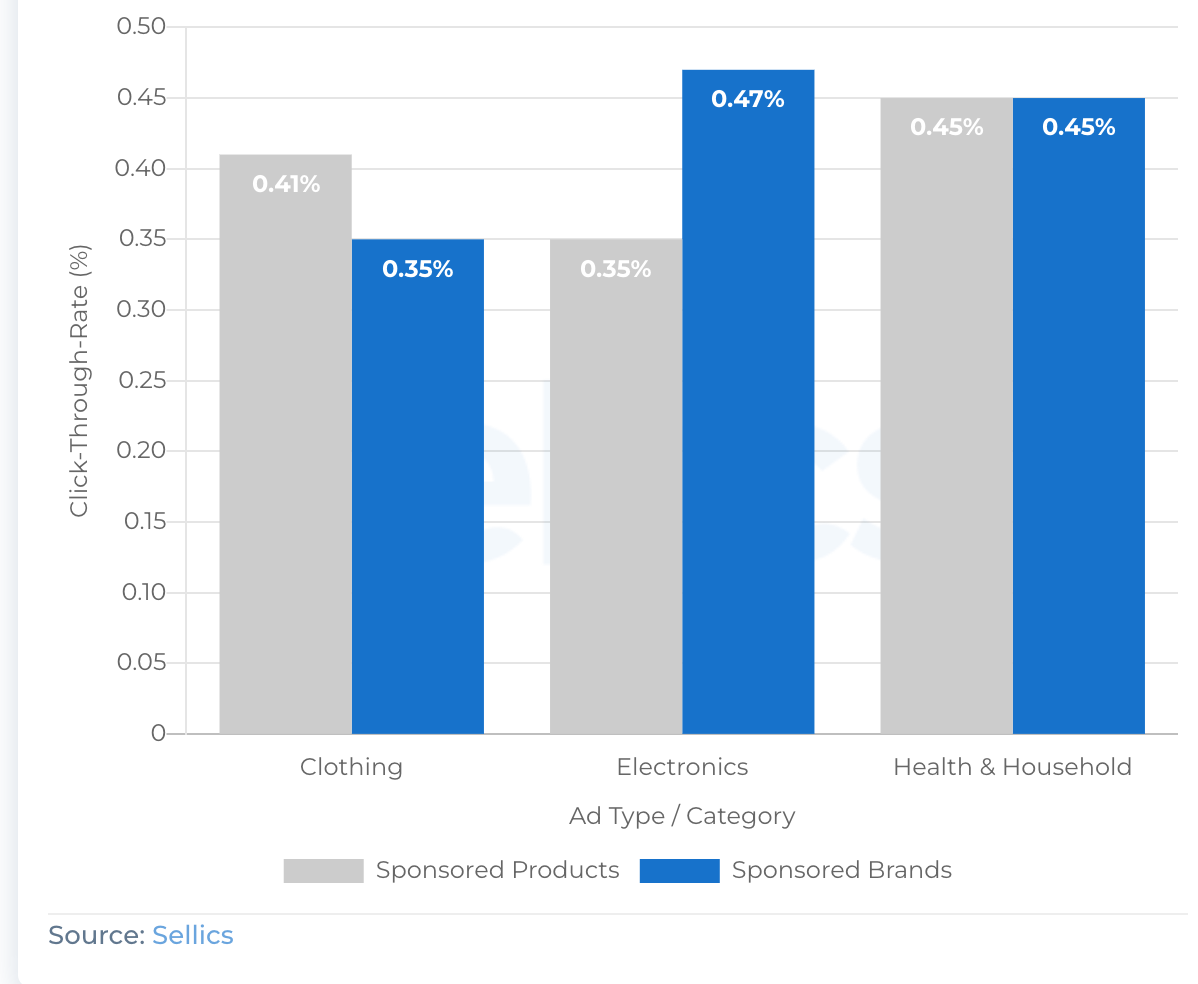
The click-through-rate (CTR) is a percentage showing how often your product ads get clicked on.
By looking at your CTR in relation to your industry benchmark, you can evaluate how appealing your ads are to your target customers, and how successfully your ads stand out from the crowd in relation to your peers. It can also help you understand if you are targeting a rather narrow or broad audience compared to your peer group.
Use the free Benchmarker to compare your CTR to your peer group and to get concrete tips for improving it.
What is a good conversion rate for Amazon Sponsored Products?
Conversion Rate Across Ad Types and Top Categories
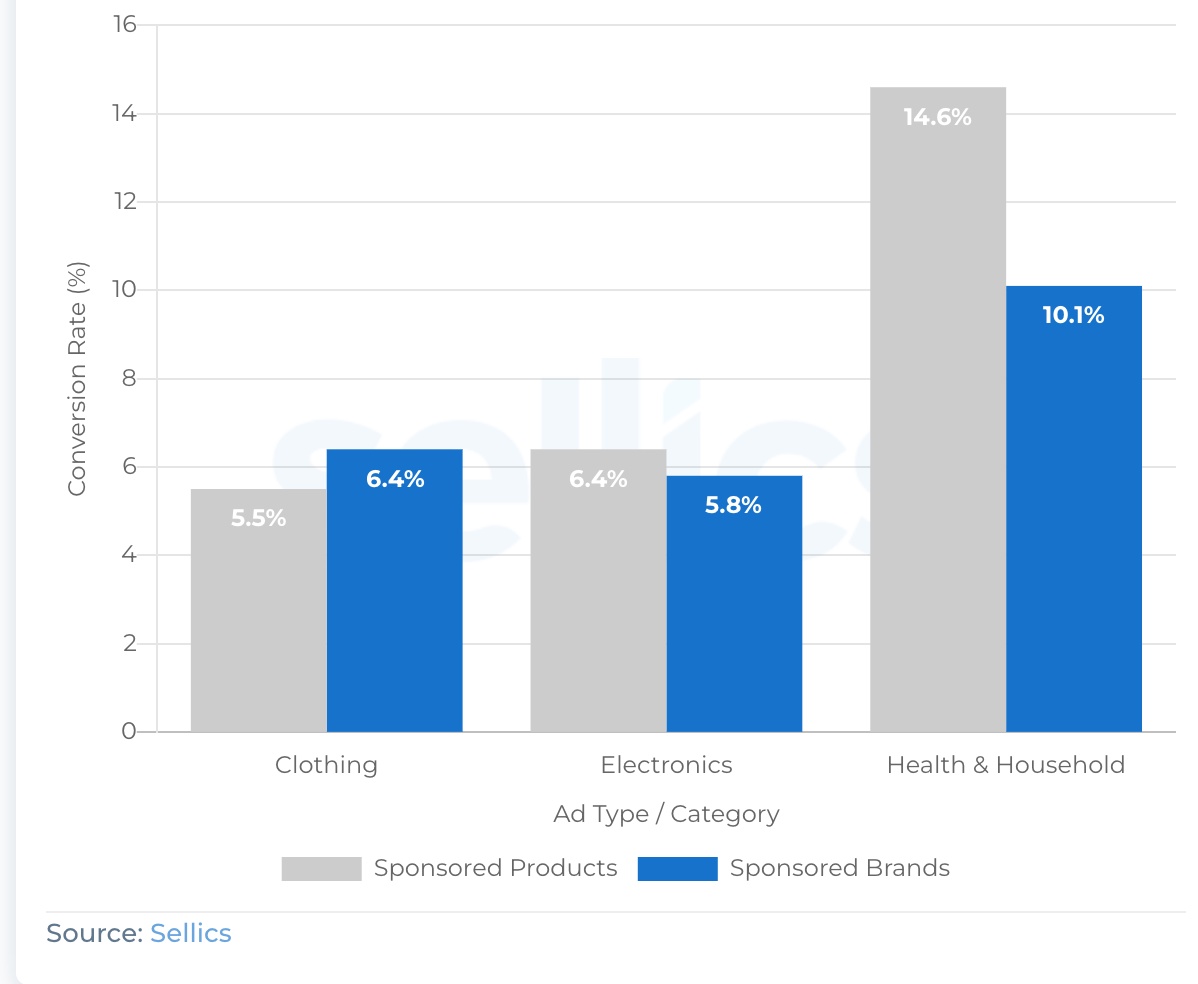
The Conversion Rate (CVR) indicates the percentage of visitors who turned into buyers after clicking on your ad.
Understanding where your Sponsored Product conversion rate stands in comparison to your peers in the same industry shows you if your products are bought more than others. This also helps you gauge how much room you have to make your product page more convincing to consumers.
Comparing CVRs across categories, the Health & Household category has a significantly higher CVR, likely because these tend to be more functional and repeat purchases. On the other hand, customers looking for products in Electronics or Clothing may be more often browsing for entertainment, without immediate intention to buy.
Use the free Benchmarker to compare your conversion rate to your peer group and to get concrete tips for improving it.
What is a good CPC for Amazon Sponsored Products?
CPC Across Ad Type and Top Categories

CPC is the amount you pay when a customer clicks on your ad. This is also an indicator of the level of competition in your category. Comparing CPC levels across these top 3 categories we see that there is highest competition in the Health & Household category, and lowest in Clothing.
Comparing your Amazon Sponsored ads CPC value with the benchmark value for your industry tells you if you’re spending too much or too little on your bids. If your CPC is higher than in your peer group, this may indicate that you are overpaying. If your CPC is much lower than in your peer group then you might miss impressions, clicks and sales because your bids are not competitive.
It’s important to remember that the optimal CPC depends on your individual products. You have to decide what you can afford to pay and what you are willing to pay.
Use the free Benchmarker to compare your CPC to your peer group and to get concrete tips for improving it.
What is a good ACoS for Amazon Sponsored Products?
ACoS Across Ad Type and Top Categories
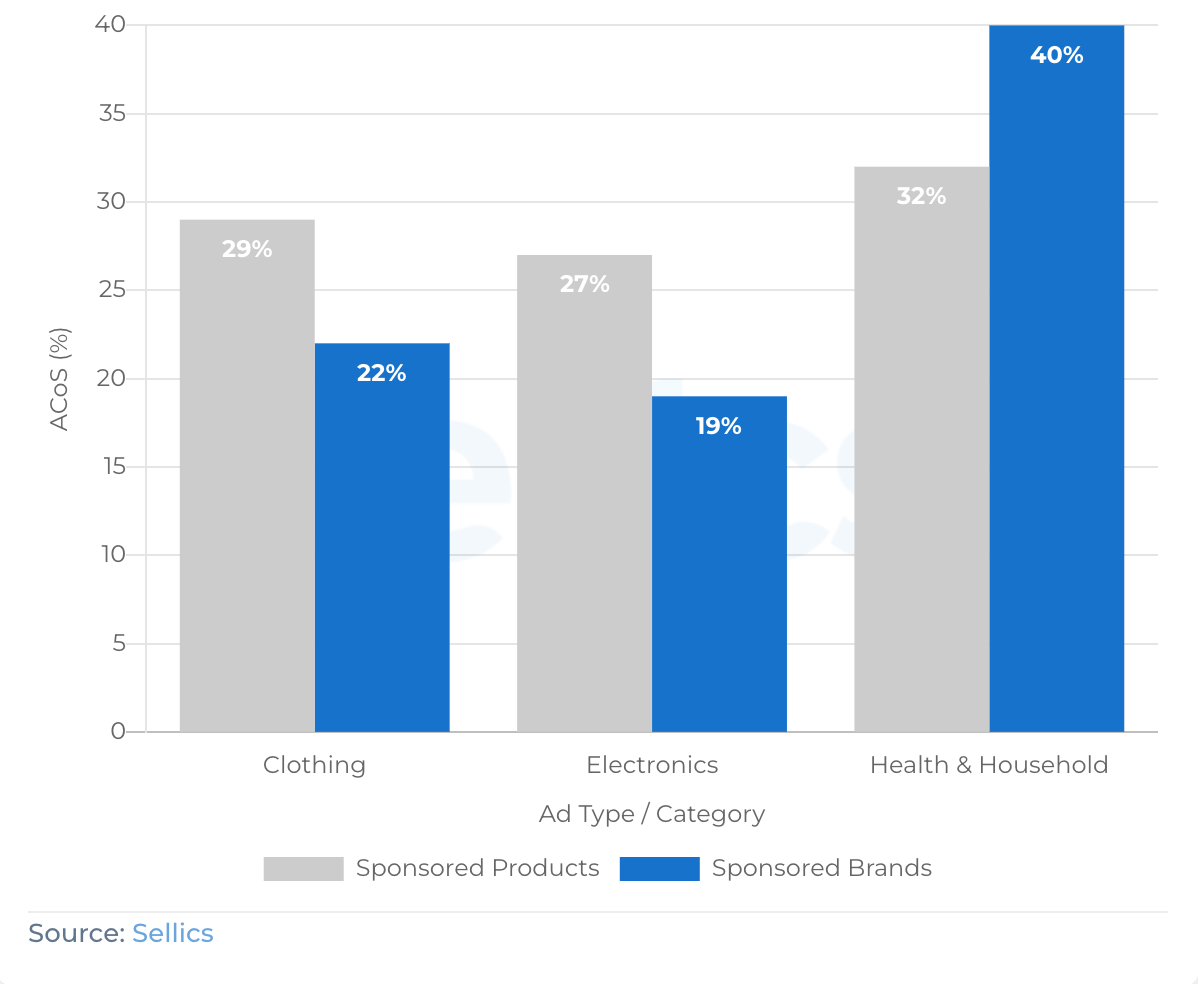
Of every dollar you earned with advertising, your ACoS shows the proportion of revenue that was spent on the ad campaign. In other words, it measures the efficiency of your ad campaign.
For example, the Sponsored Products ACoS of 32% for the Health & Household category means that for every dollar made, 32 cents was spent on the Sponsored Product ad.
Comparing your ACoS to your peer group allows you to see if there is potential to increase the efficiency of your campaigns e.g. by optimizing your bids or by adding more negative keywords.
Determining a good ACoS for your ad campaigns depends on individual factors. Similar to CPCs, you have to ask yourself what you can afford to pay (depending on your profit margin) and what you are willing to pay (depending on your advertising goals).
Use the free Benchmarker to compare your ACoS to your peer group and to get concrete tips for improving it.
How to set goals for your Amazon Sponsored Ads campaign
Advertisers running Amazon Sponsored ads ads will already know that it can be very easy to incur a loss on your product if you’re not tracking the performance of your campaigns against your costs.
In order to evaluate the performance of your Amazon PPC campaigns, you need to be clear about your goals for running Amazon ads from the outset.
Typically advertisers go for:
Maximizing sales (e.g. for a product launch) or maximizing impressions (e.g. for a brand awareness campaign). In this case, the costs are typically kept at a break-even level which is reflected by the so-called target KPI ‘break even ACoS’;
Generating incremental sales while achieving a certain profit margin which is reflected by the so-called target KPI ‘target ACoS’.
CAMPAIGN GOAL | WHEN? | HOW TO CALCULATE YOUR TARGET VALUE |
|---|---|---|
Maximise sales/impressions | E.g. product launches, brand awareness campaigns | Calculate your break-even ACoS (profit margin before ad spend) |
Achieve target profit margin | General campaigns (long-term focus) | Calculate your target ACoS (break-even ACoS – target profit margin) |
How much should I spend on my Amazon Sponsored Ads? (How to set ACoS target values)
To make a profit, don’t spend more on advertising campaigns than your margin allows. You can see this very quickly by looking at the ACoS. As long as the ACoS is smaller than the margin, you’re still making a profit. In other words, a Dollar spent on advertising will yield more than a Dollar from additional sales. An example:
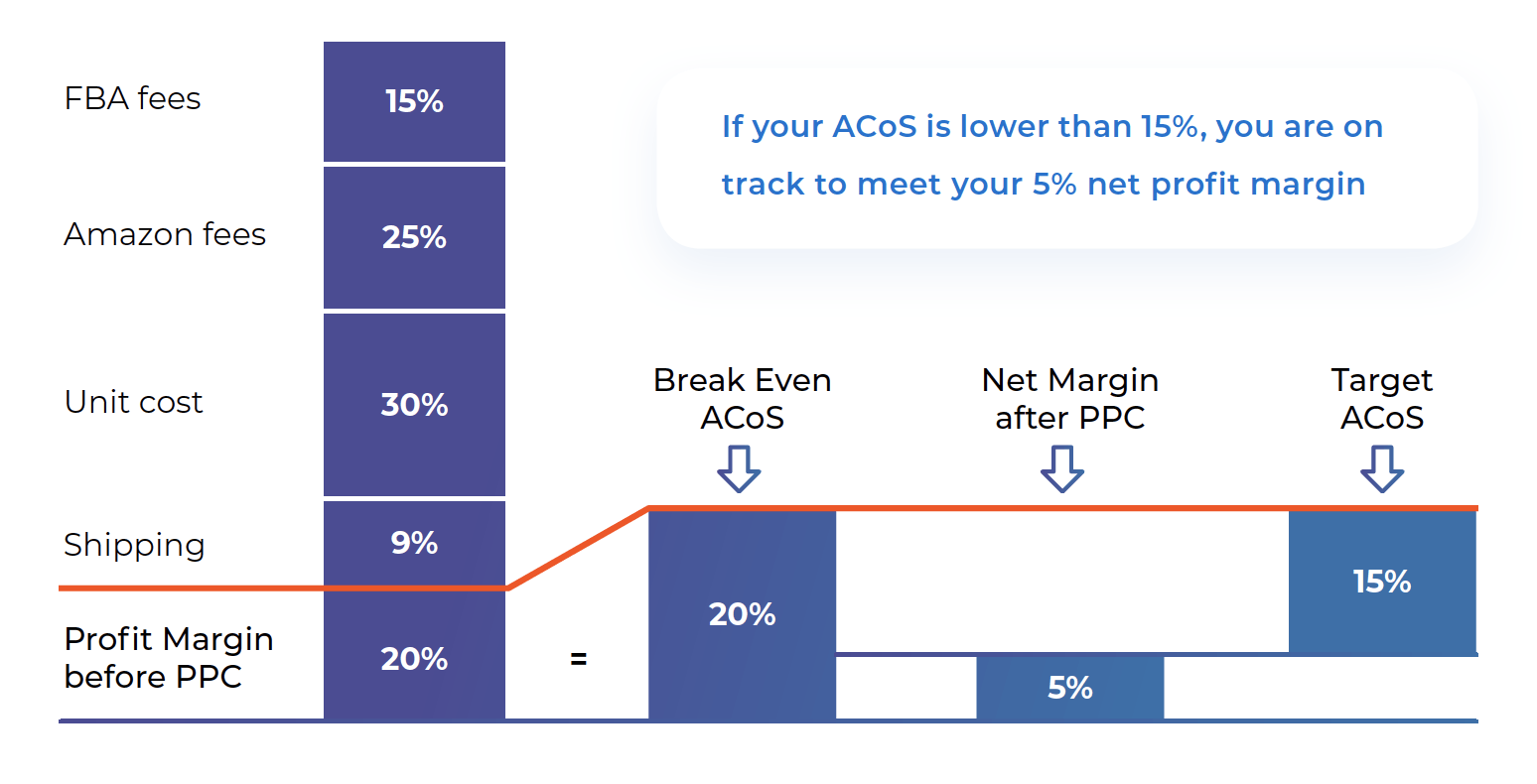
To calculate the margin, deduct all relevant costs (product-related, taxes, Amazon fees, overheads) from the price. In our example, there is still a 20% margin left to spend on advertising campaigns without loss. The so-called break-even ACoS is therefore 20%.
Break-Even ACoS = Profit Margin Before Ad Spend
If you want to leave a margin after advertising (for example 5%), you will have to subtract it from the ACoS to get your target value (target ACoS) — in our example, the target ACoS is 15%.
Target ACoS = Profit Margin Before Ad Spend - Target Profit Margin After Ad Spend
Tip: Your break-even ACoS is calculated automatically for all your campaigns, ad groups, and keywords in the Sellics Advertising module. Immediately pinpoint the campaigns, ad groups, or keywords that are unprofitable and losing your money.

How does targeting for Amazon Sponsored Products ads work?
There are two main elements to Sponsored Products targeting:
Keyword targeting
Product targeting
Keyword targeting and match types
With keyword targeting advertisers can define keywords that are matched with shopper’s search queries where they want their ad to appear.
Ads will either appear in search results for the matched search terms or on product pages that are visited from these search results.
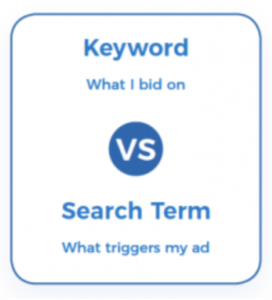
In order to improve your ad targeting, you would need to utilize keyword match types to ensure that your ad is displayed for only the most relevant search terms to your product. Keyword Match Types determine the degree of match between the customer search term and your keyword in order for your ad to appear.
In your Sponsored Products campaign, combine different match types to leverage their unique advantages.
There are three keyword match types available:
MATCH TYPE | KEYWORD | AD APPEARS FOR SEARCH TERM | AD DOES NOT APPEAR FOR SEARCH TERM |
|---|---|---|---|
Broad (search term contains keyword in any word order) | wallet men | wallet men wallet men black nylon wallet men wallet black men men wallet leather | purse men wallet women |
Phrase (search term contains keyword in identical word order) | wallet men | wallet men wallet men black nylon wallet men | purse men wallet women wallet black men men wallet leather |
Exact (Word-for-word match between keyword and search term) | wallet men | wallet men | purse men wallet women wallet men black nylon wallet men wallet black men men wallet leather |
Matching search terms include the following variations:- Upper/lowercase: (e.g. ‘wallet' covers ‘Wallet')- Singular/plural (e.g. ‘wallet' covers ‘wallets')- Special characters (e.g. ‘entrecote' covers ‘entrecôte')- Slight spelling errors (e.g. ‘wallet' covers ‘walllet')- Filler words (e.g. ‘wallets' covers ‘for wallet')
How to do basic keyword research
If you’re just starting out and don’t know what keywords to use for your product, or if you simply want to do more thorough keyword research, check out Sonar, Sellics’s free keyword research tool.
With Sonar you can find relevant keywords for your product for Amazon’s US and European marketplaces. When you type in a search term in Sonar, you will be provided with a list of related keywords, ranked by relevance and search volume.
You can download the entire list of relevant keywords as an excel sheet for free. This will give you a great starting point for deciding which keywords you should bid on for your Amazon Sponosred ads campaign.
Automate your keyword research
Use the keyword rules in Sellics Advertising or our AI solution to automate your target research for keywords and ASINs and continuously optimize your targeting. Start your free trial!
Product targeting (ASINs and categories)
For product targeting, sellers can fine-tune Sponsored Product campaigns to target categories and ASINs.
ASIN targeting enables you to target specific ASINs you want your ad to show up for. In ASIN targeting, your ad will appear in the search results page if the ASIN that you are targeting is on the search results page, and on the product page of the ASIN you are targeting.
There are generally four strategic approaches for ASIN targeting based on the following matrix:
ASIN targeting strategies | Own ASIN | Competitor ASIN |
Substitute ASIN (e.g. two different phones) | Cross-promotion/defense against competitor ads | Taking competitor’s traffic |
Complement ASIN (e.g. phone and case) | Cross-selling/defense against competitor ads | Piggybacking on competitor’s traffic |
How to use Amazon to do basic ASIN research
If you’re just starting, here are some quick and easy ways to identify ASINs that you can target with your campaign:
Look at the “Products related to this item” section on the Amazon product detail page for your product to get substitute ASINs to target.

Check the “Customers who viewed this item also viewed” section to see potential complement ASINs to target.

Look at the reports for shopping behavior and bundling provided in your brand analytics dashboard in Seller and Vendor Central (aka ARA or Amazon Retail Analytics).
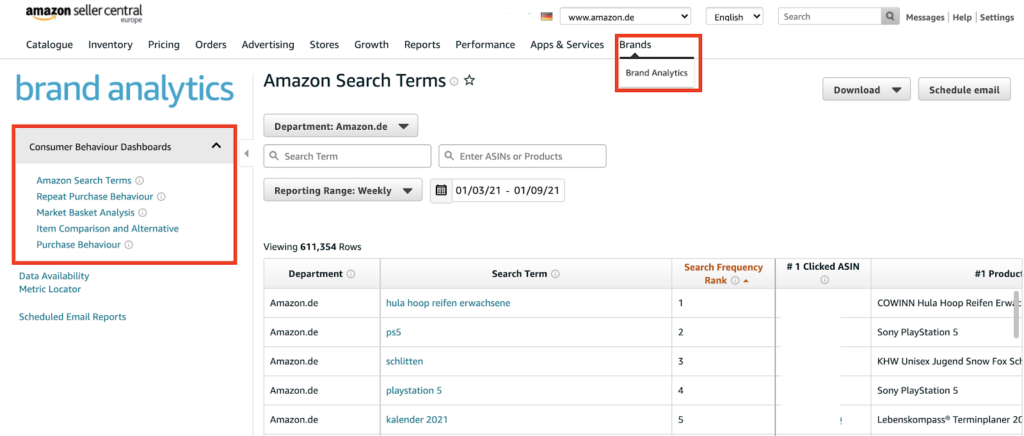
Automate your ASIN research
Use the keyword rules in Sellics Advertising or our AI solution to automate your target research for keywords and ASINs and continuously optimize your targeting. Start your free trial!
Category Targeting enables you to target your own product categories on Amazon. This targeting method works especially well for for new products/inventions and products that are more likely to be purchased when browsing through categories, i.e. fashion, gifts, etc.
Category targeting is also a good choice for generating brand awareness as this targeting method tends to generate many impressions in a quick and easy way.
Please note: If possible, create separate campaigns for category targeting as it usually generates many impressions and clicks. It therefore tends to use larger budgets compared to other targeting methods. Separate campaigns give you more budget control and avoids that campaigns run out of budget before other targeting methods get enough impressions.
Amazon Sponsored Products Strategy for Beginners
Before you start…
… make sure you refine your product listing SEO before kicking off an ad campaign. Sponsored Products campaigns are usually more successful with an Amazon product page that also considers SEO. There are 2 main reasons for this:
Keyword Reach: Amazon displays an ad for a specific search term only if the product page includes similar keywords. Optimize the product page for all relevant keywords.
CTR & CR: Good pictures, text, reviews, etc. on the product page increase the click-through rate and conversion rate of the product and thus of the advertisements.
Sponsored Ads start-up strategy
In this article we’ll explain the start-up version of our Sponsored Products strategy blueprint. We will also publish an advanced version soon.
For each product or set of products (for a set of products, make sure that the products selected have similar keywords and profit margins) we recommend the following structure:
1 automatic campaign (with 1 automatic ad group)
1 manual campaign (with 1 ad group for broad match keywords and 1 ad group for ASIN targets)
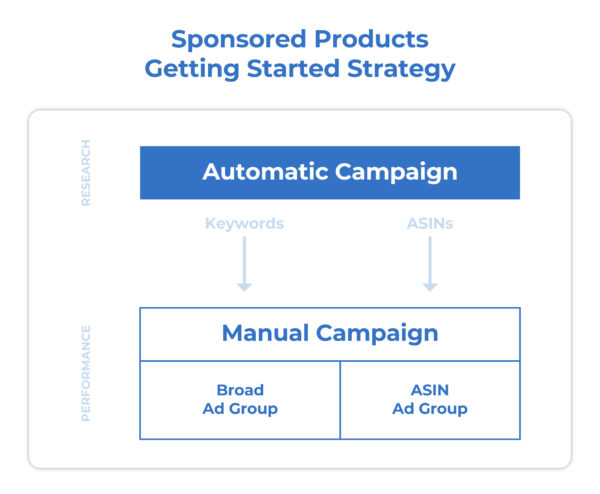
The logic behind this is to use your automatic campaign for continuous target research with minimal effort and regularly move the high-performing keywords and ASINs to your manual campaign, where they can be precisely optimized for highest performance (see more details about this process below).
This approach combines the benefits of both automatic campaigns (low effort) and manual campaigns (high precision).
Creating your Sponsored Products campaign
Creating an automatic campaign is relatively easy. All you need to do is name your campaign (and ad group) and define a budget and a CPC bid. As soon as your campaign kicks off, Amazon examines the advertised products and automatically starts displaying your ads for selected search terms.
Create a manual campaign to add your own choice of keywords. An excellent resource to research these keywords is Sonar, our free Amazon keyword research tool. For a decent basic coverage, research the 20 to 30 top keywords and add them to the match type “Broad” (See more info about keyword research above.)
Also include one ASIN ad group with around 20 ASINs in your manual campaign. To find ASINs take a look at your brand analytics dashboard or look at the “Products related to this item” section or “Customers who viewed this item also viewed” section on the Amazon product detail page for your product. (See more info about ASIN research above.)
The following table summarizes all the settings for the recommended strategy.
SETTINGS | AUTOMATIC | MANUAL (BROAD KEYWORDS) | MANUAL (ASIN) |
|---|---|---|---|
Budget | $15 per product | $25 per product | $25 per product |
Campaign name | SP | ‘Fill in ASIN’ | Auto | SP | ‘Fill in ASIN’ | Manual | SP | ‘Fill in ASIN’ | Manual |
Ad group name | SP | ‘Fill in ASIN’ | Auto | SP | ‘Fill in ASIN’ | Manual | KW Broad | SP | ‘Fill in ASIN’ | Manual | ASIN |
Products | Product or product set with similar keywords and margins | Product or product set with similar keywords and margins | Product or product set with similar keywords and margins |
Initial Targets | None | Around 20 broad keywords | Around 20 ASINs |
Initial Negative Targets | Initial targets from ‘Broad’ ad group (as negative phrase) and from ‘ASIN’ ad group | None | None |
Ad group bid | Suggested bid by Amazon | Suggested bid by Amazon | Suggested bid by Amazon |
Target bid | Suggested bid by Amazon | Suggested bid by Amazon | Suggested bid by Amazon |
In this setup we are using negative targets to make sure impressions are generated only in the ad groups where we want them.
Why? Certain keywords and ASINs could be both targeted by the automatic and manual campaigns.
However, as soon as a target is added to a manual campaign, impressions in the automatic campaign have to be stopped, because this target will now be optimized and fine tuned in the manual campaign.
To stop the impressions in the automatic campaign, a negative phrase keyword or ASIN is added there whenever the target is added to the manual campaign. This happens when the campaigns are created or when a target gets harvested and transferred from automatic to manual.

Amazon Sponsored Products: routine optimization
Routine optimization is critical to the success of ad campaigns. Make sure you always collect enough data to support your decisions, though. Once you have collected enough data, you can perform the following optimization procedures in the automatic and manual campaign:
Transfer keywords and ASINs from automatic to manual campaign
You should regularly transfer your top-performing search terms (keywords and ASINs) from your automatic campaign to the broad match and ASIN ad groups in your manual campaign to be able to precisely optimize them there.

An example:
The relevant search term ‘wallet blue’ is identified in the automatic campaign.
‘Wallet blue’ is added as a keyword to the manual broad match ad group to optimize the keyword bid etc. there.
At the same time, the negative phrase keyword ‘wallet blue’ needs to be added to the automatic campaign so that impressions for this search term are stopped there.
You can identify the best performing search terms in your Automatic Campaign search term report (access it via the campaign manager or download it as an Excel file) and in Sellics Advertising.
Automate this task
By using best practice rules sets in Sellics Advertising, you can automatically transfer top-performing search terms from your automatic to manual campaign, saving time and increasing efficiency. Alternatively, use Autopilot to fully automate your Amazon PPC campaigns.

Use negative keywords
You will want to periodically track the search terms (keywords and ASINs) running in your automatic campaign and manual campaign that are generating clicks without conversions and add them as negative keyword / ASINs. You can learn more about negative keywords here.
When filtering out unprofitable search terms from your Amazon Sponsored ads campaigns and ad groups, your aim is to remove:
Irrelevant search terms that clearly do not apply to your product.
Unprofitable search terms that may be relevant to your product, but only generate clicks without conversions.
When utilized correctly, negative keywords will help you achieve a lower ACoS.
Automate this task
By using best practice rules sets in Sellics Advertising, you can automatically add negative keywords and transfer top-performing search terms from your automatic to manual campaign, saving time and increasing efficiency. Alternatively, use Autopilot to fully automate your Amazon PPC campaigns.

Optimize bids for your Amazon CPC ads
In order to find the ‘optimal CPC’ for your campaigns, ad groups, ASINS and keywords, you will need to define your campaign goal and ACOS target values (see above or read our CPC optimization guide for further guidance):
Goal is maximizing sales/impressions:Goal is achieving target profit margin after ad spend:
Once you have defined your goal and targets you can test different CPCs to see which one brings you the closest to your target. Below are some standard rules for adjusting and optimizing your CPC bids:
Keywords/ASINs with good ACoS:Keywords/ASINs with poor ACoS:
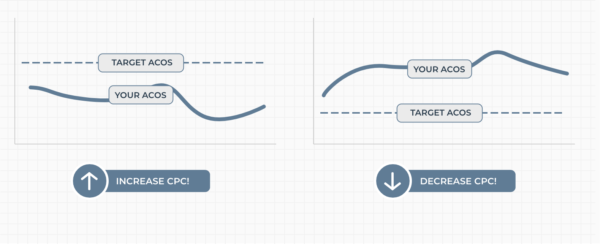
Keep in mind it’s critical to allow for sufficient waiting time between keyword and ASIN bid changes, to ensure you have collected enough data (impressions, clicks, conversions, etc.) to help you assess whether further bid adjustments are necessary.
Automate this task
By using best practice rules sets in Sellics Advertising you can automate your bid management. Alternatively, use Autopilot to fully automate your Amazon PPC campaigns.

Summary: campaign optimization
AD GROUP | TARGETS | NEGATIVE TARGETS | AD GROUP / TARGET BIDS |
|---|---|---|---|
Automatic | Turn converting or relevant search terms into keywords for the manual campaign (broad or ASIN) | Exclude irrelevant or expensive search terms | – IF ad group ACoS < / >Target value, THEN increase / decrease ad group bid |
Broad | – | Exclude irrelevant or expensive search terms | – IF ACoS < / >Target value, THEN increase / decrease target bid – IF conversions = 0 after X clicks, THEN reduce bid or pause – IF impressions close to 0, then check product keywords or increase bid |
ASIN | – | – | – IF ACoS < / >Target value, THEN increase / decrease target bid – IF conversions = 0 after X clicks, THEN reduce bid or pause – IF impressions close to 0, DANN increase bid |
FAQs
Where do Sponsored Products ads appear when I use Product Targeting?
With product targeting (category or ASIN) Sponsored Product ads appear both on Amazon product detail pages and in search results. We wrote more about this in our case study where we conducted test experiments on SP placements.
Where do I find theASIN of products on Amazon?
The ASIN is stated under ‘product information’ on each Amazon product page.
Why combine both campaign types?
While an automatic campaign is great for keyword research, a manual campaign is great for more precise ad targeting. We recommend using both to reap benefits of both campaign types.
Key Takeaways
By advertising on Amazon and with Amazon Sponsored Products ads specifically, you can get your products in front of shoppers who are later in the buyer’s journey (lower funnel). That means these shoppers already know what product they want and have a higher likelihood of making a purchase.
With Amazon Sponsored Products ads, you can set your daily ad budget, and decide how much to bid for your keywords and ASIN targets.
We recommend a Amazon Sponsored Products strategy where you use your automatic campaign for continuous target research with minimal effort and regularly move the high-performing keywords and ASINs to your manual campaign, where they can be precisely optimized for highest performance (see more details about this process below).
Try Sellics Advertising
Sellics offers the most advanced Amazon PPC solution on the market. When it comes to automating and scaling your Amazon PPC campaigns, Sellics Advertising has all the tools, resources and expert support.
Try Sellics’s free tools to improve your Amazon PPC campaigns: use Sonar for keyword research, and the Benchmarker [Beta] to compare your performance to your peers and identify the KPIs you can improve.
To get started or learn more about how Perpetua can help you scale your Amazon Advertising business, contact us at hello@perpetua.io